The world's 16 most expensive stadiums, ranked
The world's most expensive stadiums, ranked
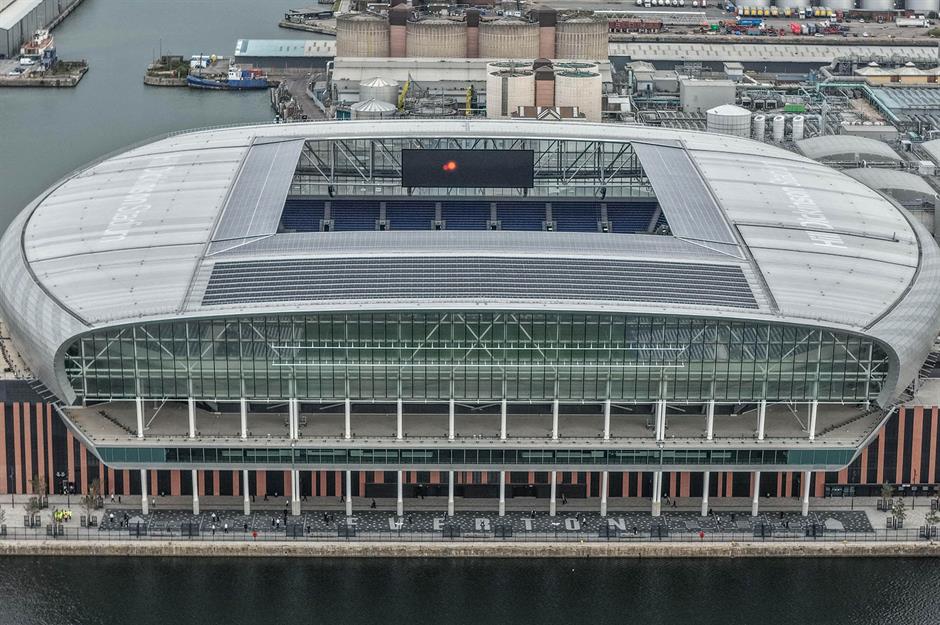
As Everton's new stadium (pictured) prepares to welcome Premier League fans, fellow British football team Manchester United plans to build a new 100,000-seat state-of-the-art stadium after 115 years of playing at Old Trafford. The project, which is being delivered by star architect Norman Foster’s firm and due to open within the next five years, has an estimated price tag of up to $5.4 billion (£4bn) – making it one of the most expensive sports facilities in the world.
However, stadium construction is notorious for going over budget and over schedule, no matter the sport. From National Football League (NFL) monoliths in the US to Premier League palaces and Olympic showpieces, read on to discover the world's 16 most expensive stadiums, ranked by total cost. We also reveal who paid for them and whether they came in on time and on budget.
All dollar amounts in US dollars and the cost of pre-2022 projects have been adjusted for inflation.
16. Hill Dickinson Stadium, UK: $1 billion (£800m)
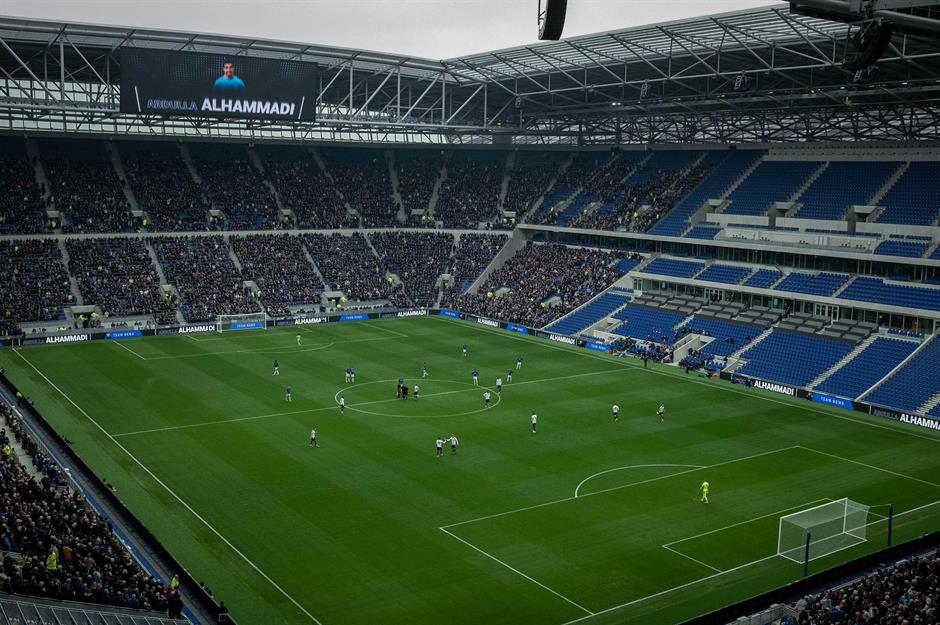
Everton Football Club has struggled for years to develop a new stadium, eventually landing on the abandoned Bramley-Moore Dock in Liverpool, England. Along with building a futuristic new facility, the owners envisioned a venue with the capacity to attract megastar music tours and other cultural events in addition to the team’s Premier League games.
However, with the dock’s historic legacy and seaside location, this wasn’t a straightforward construction project. Historic preservation work ran to about $71 million (£55m) for the original dock walls and rail tracks, among other infrastructure. There were also major dredging operations to collect sand from the Irish Sea for infill – not to mention encouraging two porpoises to leave the docks before sealing could take place. To make matters even worse, the Royal Navy needed to remove 12 unexploded bombs dating back to the Second World War.
16. Hill Dickinson Stadium, UK: $1 billion (£800m)
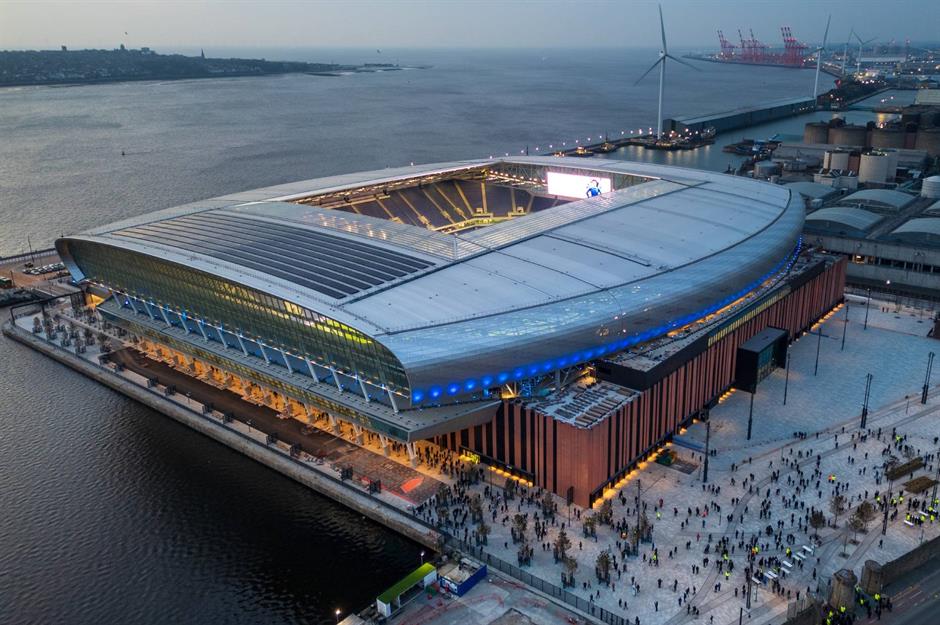
Work officially began in 2021 for the 52,000-capacity stadium and was completed on time in late 2024, though not on budget. Initially expected to cost $650m (£500m), the total price has been cited closer to $1 billion (£800m) now that the project is complete, with the massive increase attributed to spiralling supply chain costs. Around $20 million (£15m) came from public money.
Fans had a first chance to check out the new ground in February this year when the facility hosted a friendly between Everton and Wigan Athletic Under-18s. As the Premier League season kicks off, the impressive new stadium is now fully open for business.
15. Lucas Oil Stadium, USA: $1.06 billion (£820m)
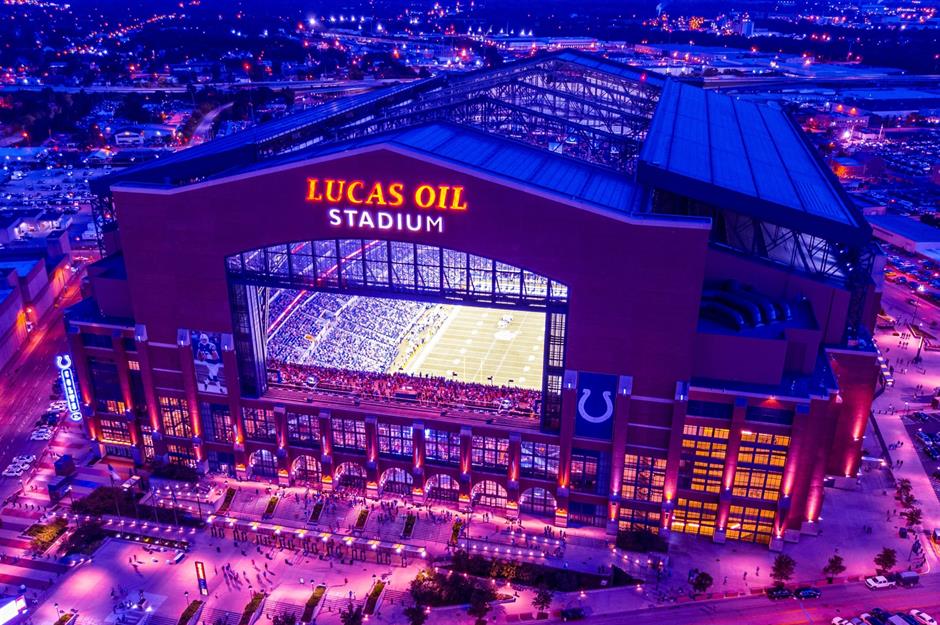
Home of the NFL’s Indianapolis Colts, the Lucas Oil Stadium cost $720 million to build when it opened in 2008. That’s $1.06 billion (£820m) in today's money, making it one of the most expensive sports facilities in the world. The State of Indiana, City of Indianapolis and the Colts jointly footed the bill.
Construction started in 2005 on a site adjacent to the team’s former home, the RCA Dome. This new venue was a major upgrade, and it provided coveted amenities like luxury suites and club seats. Design features included a retractable roof, as well as retractable windows on one side to provide views of the city skyline. The city’s heritage was referenced with a brick façade on the steel and glass structure.
15. Lucas Oil Stadium, USA: $1.06 billion (£820m)
Two decades after construction broke ground, the stadium has seen plenty of gridiron action and more. It's hosted a number of concerts, including Taylor Swift’s Eras Tour, and a temporary Olympic-sized pool was created on the field to host the 2024 US Olympic swimming trials (pictured).
And that’s not all. Designed with extra locker rooms, the football stadium hosted three Final Four basketball tournaments for the National Collegiate Athletic Association (NCAA), with two more scheduled for 2026 and 2029.
14. Arena BRB Mané Garrincha, Brazil: $1.2 billion (£920m)
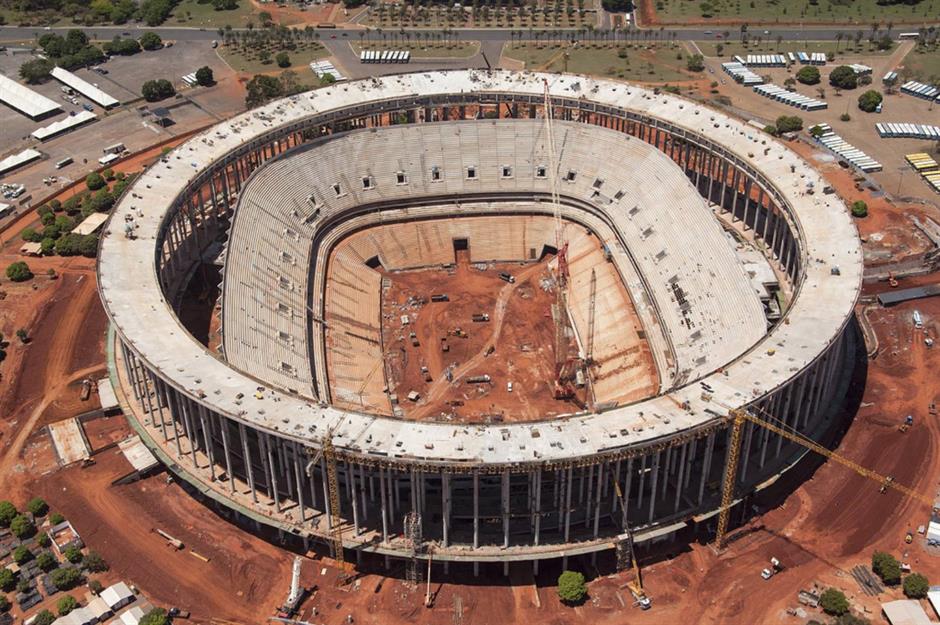
Previously known as Mané Garrincha Estadio Nacional, this multi-purpose stadium in Brasilia dates back to 1974, though it’s undergone a massive overhaul since then.
Following decades of wear and tear, officials decided to upgrade the facility to create a more modern stadium to host the 2013 Confederations Cup and 2014 World Cup in Brazil. This complete rebuild was initially expected to cost about $500 million, before construction delays and poor planning almost doubled that figure to $900 million. That's around $1.2 billion (£920m) today.
14. Arena BRB Mané Garrincha, Brazil: $1.2 billion (£920m)
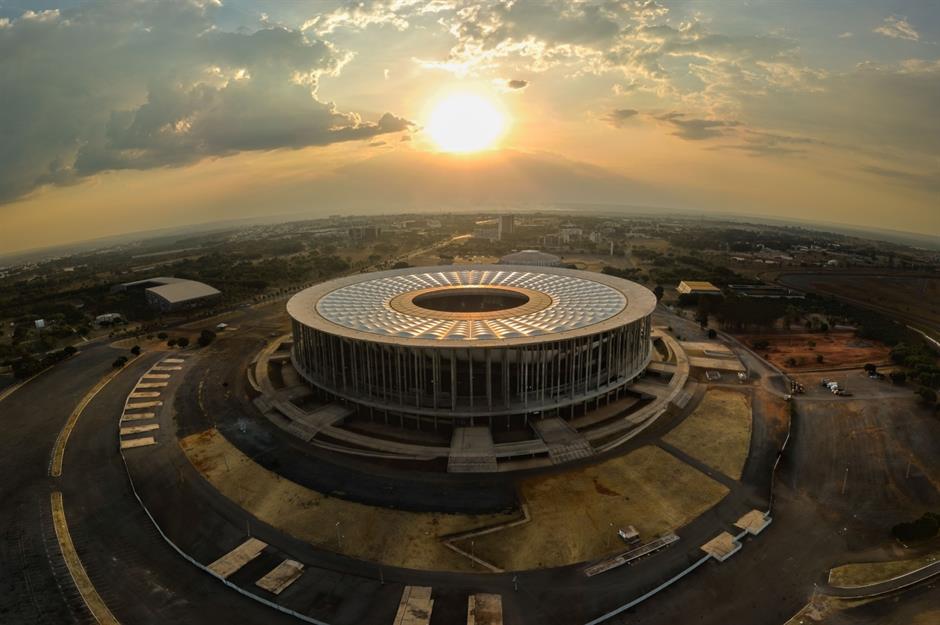
Over the last 10 years, the 72,000-seat venue – the largest in Brazil – has hosted numerous sporting events as well as major concert tours. During the 2016 Summer Olympics in Rio de Janeiro, various football teams came to Brasilia to compete at the Arena BRB, which also hosted games for the 2021 Copa América.
That said, there has been concern that the stadium is underutilised, especially considering its hefty price tag, which was covered by the public purse. Local teams who play there can't fill the venue and generate little revenue.
13. Singapore Sports Hub, Singapore: $1.3 billion (£1bn)
Singapore’s first state-of-the-art sports facility opened in 1973 to much acclaim. The National Stadium boasted an eight-lane track, football field and air-conditioned squash courts. However, by the turn of the century, the venue needed upgrades, and demolition loomed.
In its place was built an integrated sports hub, part of the government's ambitions to improve health and wellbeing. The venue hosts professional athletes as well as community events.
Construction groundbreaking was originally scheduled for 2008, but the impact of the global financial crisis delayed it until 2010.
13. Singapore Sports Hub, Singapore: $1.3 billion (£1bn)
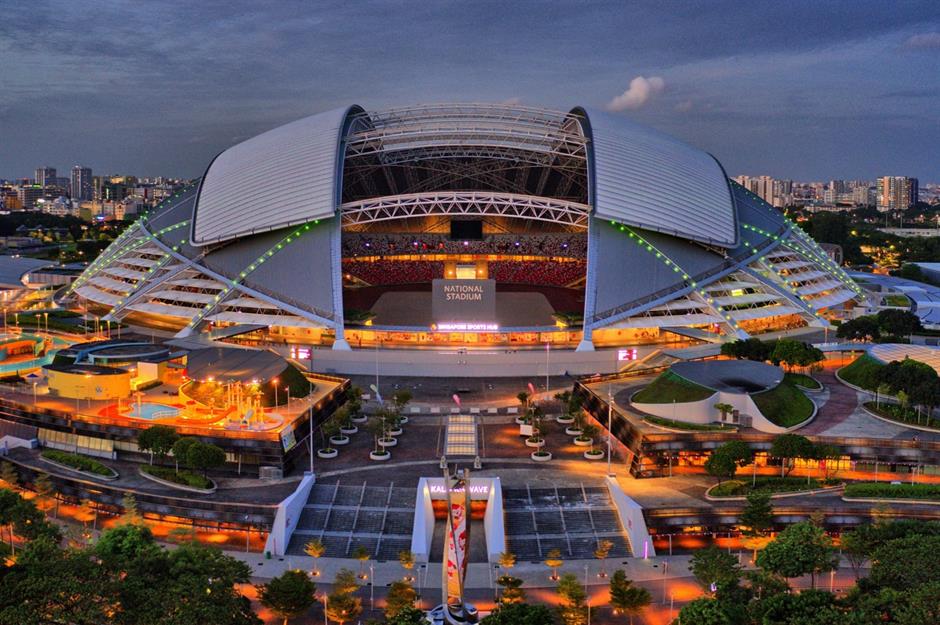
Construction was completed in 2014, and the iconic National Stadium was demolished in 2010. Using a public-private partnership delivery method, the government’s investment in the construction was limited to S$1.3 billion, which is around $1.3 billion (£1bn) when adjusted for inflation.
The new 55,000-capacity stadium got off to a bumpy start. It was heavily criticised for its patchy pitch, which led some visiting teams to bench star players. Fixing the supposedly terrible turf cost millions, requiring the integration of artificial fibres and the installation of specialised grow lights.
Today, the facility hosts a multitude of events including rugby, cricket, concerts and national and community events.
12. U.S. Bank Stadium, USA: $1.46 billion (£1.1bn)
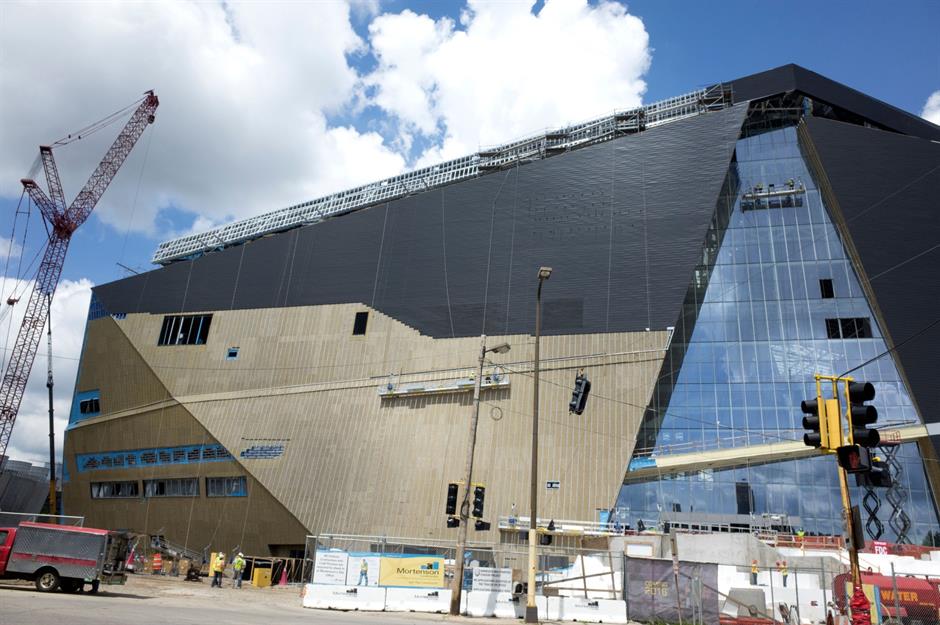
The Minnesota Vikings NFL team had long shared Minneapolis’ Metrodome stadium with the local baseball team, the Minnesota Twins. The facility’s air-supported roof, comprising layers of fabric and Teflon-coated fibreglass material, had a reputation for struggling in the city’s harsh winters. In fact, it completely collapsed in a December 2010 blizzard, leaving the stadium defunct for the rest of the season.
In 2012, the Minnesota Legislature and the Minneapolis City Council approved funding for a new $975 million (£752m) multi-purpose stadium to replace the Metrodome. Construction started in 2013 and lasted two-and-a-half years, finishing on schedule in 2015, though slightly over budget at $1.1 billion, the equivalent of $1.46 billion (£1.1bn) in today's money.
That’s not to say the project went swimmingly. Polling showed little more than a third of the state supported taxpayer money being used for the construction.
12. U.S. Bank Stadium, USA: $1.46 billion (£1.1bn)
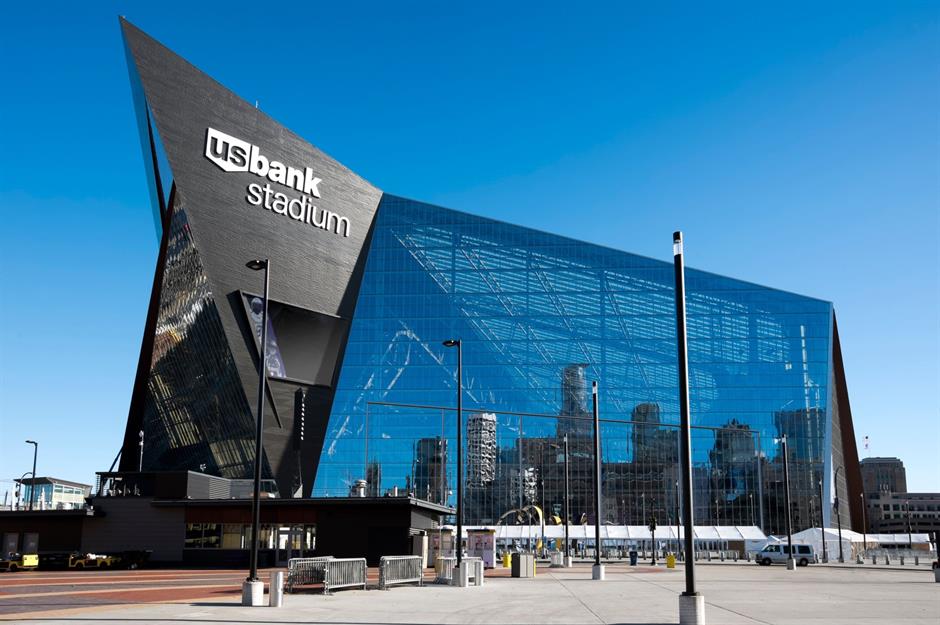
Criticism mounted as construction continued. Designed to mimic a Viking longboat, the hulking edifice is suited to the brutal local climate. It eschews a retractable roof for one made of weatherproof translucent panels that allow an inflow of natural daylight but no snow.
However, environmental groups quickly pointed out that birds are unable to distinguish this particular glass and called for a different type that would protect migrating species. The cost difference, estimated at $1.1 million (£850k), was deemed too expensive. A 2019 study determined that the stadium kills at least 100 birds a year.
Fans, however, appear to love the facility, voting the Vikings and U.S. Bank Stadium’s game-day experience as the best in the NFL in 2024.
11. AT&T Stadium, USA: $1.7 billion (£1.3bn)
One of the most widely recognised teams in the NFL, it may surprise sports fans to discover the Dallas Cowboys actually play in Arlington, Texas. With the team’s lease at Texas Stadium set to expire in 2008, and the owners eager to have a facility capable of hosting mega sports events like the Super Bowl, they set their sights on building a brand-new stadium ready for the 2009 season.
In April 2004, the team proposed a location in Dallas, with construction expected to cost $650 million (£500m) and taxpayers picking up $425 million (£330m) of the total. County officials declined the opportunity. Just two months later, Arlington officials revealed arrangements for a new stadium with the city contributing $325 million (£250m), around half the cost. Any increases would be covered by the Cowboys, which also secured a $150 million ($115m) loan from the NFL.
11. AT&T Stadium, USA: $1.7 billion (£1.3bn)
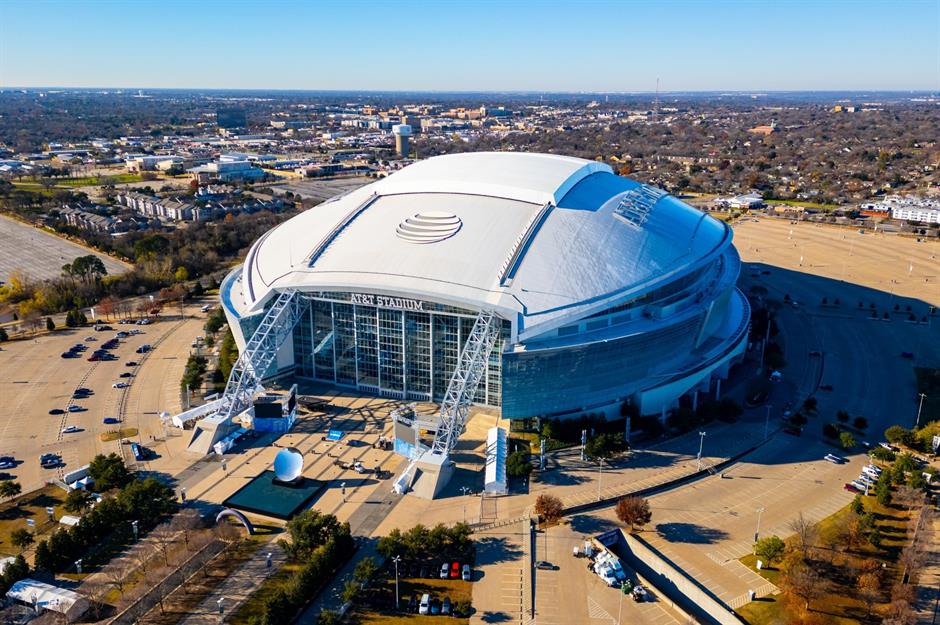
Construction started in 2006 and was completed in time for the 2009 season. However, the estimated $650 million (£500m) price tag had nearly doubled to $1.15 billion, or $1.7 billion (£1.3bn) in 2025 money.
There’s a lot of bang for your buck at this stadium though. It seats 80,000 but can hold up to 105,000 with standing capacity. Plus, it was deemed one of the grandest stadiums when it opened, boasting the world’s largest Jumbotron video screen, a retractable roof, guest amenities like plush stadium seats, luxury boxes and even an art collection.
As with many of the venues on this list, AT&T Stadium is more than just a home to the Cowboys. It hosts an array of sports and cultural events, including the heavyweight boxing match between Mike Tyson and YouTuber Jake Paul in 2024. It’s currently undergoing a $295 million (£228m) renovation in preparation for the 2026 FIFA World Cup.
10. Levi’s Stadium, USA: $1.74 billion (£1.35bn)
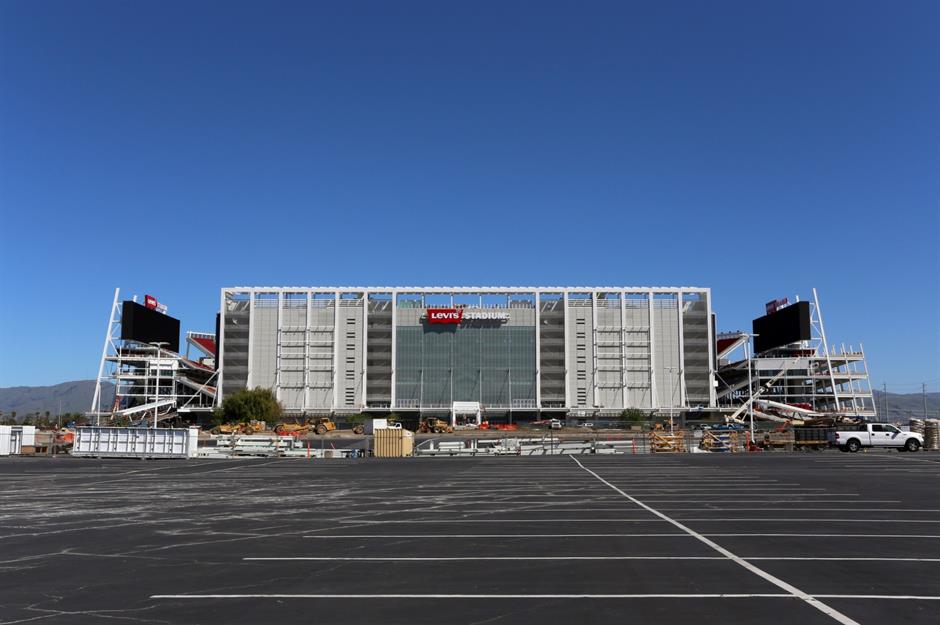
There’s a similar story behind the NFL’s San Francisco 49ers and Levi’s Stadium. As in Dallas, city and team officials struggled for nearly a decade to reach an agreement on replacing Candlestick Park. In 2006, the owners switched tactics, pursuing a new facility 40 miles (65km) south in Santa Clara, California.
Though the agreements, which specified the team could keep 'San Francisco' in its name, didn’t require any taxpayer money, officials chose to put the initiative to a vote with a ballot measure in June 2010, which passed with 58% support. Construction started in Santa Clara in April 2012.
10. Levi’s Stadium, USA: $1.74 billion (£1.35bn)
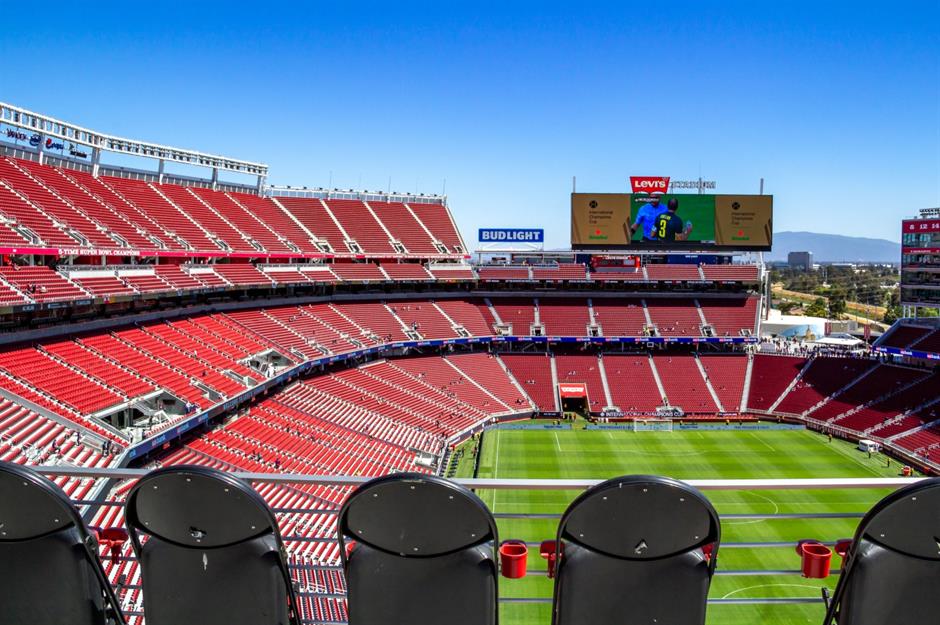
The new stadium finished on time and on budget at $1.3 billion in 2014, the equivalent of $1.74 billion (£1.35bn) today. Design and construction for the 68,500-seat facility emphasised sustainability, making it the first new-construction NFL stadium to achieve LEED Gold certification. This included using recycled and reclaimed building products, installing solar panels and even creating a green roof with vegetation native to the Bay Area.
However, a few issues cropped up following its opening. Fans suffered heat exhaustion sitting in the stadium's eastern side, where there isn't any shade. Due to its proximity to the San Jose airport and other design factors, it’s not possible to add any sunshades or other structures that would increase the stadium’s height. Meanwhile, pilots flying in and out of the nearby airport reported being blinded by the stadium’s lights during night games in 2015.
Despite these early hiccups, Levi’s Stadium saw 97% of 49ers season ticket holders renew their membership over the first four years. It’s also hosted all sorts of American football competitions as well as concerts, FIFA and Major League Soccer (MLS) games and even motocross and monster truck events over the last decade.
9. Wembley Stadium, UK: $1.8 billion (£1.4bn)
The UK’s Wembley Stadium in North London cost more than £789 million to build when it opened in 2007, the equivalent of $1.8 billion (£1.4bn) in 2025 money. The initial budget in 2000 was only half that at £326.5 million ($788m/£609m today). There were numerous delays to construction, ranging from a lack of financing to faulty sewer pipes, all driving up the costs.
Around £161 million ($345m/£267m today) of public money was used to fund the construction, and the stadium opened a year behind schedule.
9. Wembley Stadium, UK: $1.8 billion (£1.4bn)
An international icon, the stadium seats 90,000 and is the largest in Europe. Wembley regularly hosts high-profile sporting events and concerts. It also provided a temporary home for Premier League football team Tottenham Hotspur during its own stadium construction project.
Governing body the Football Association (FA) had considered selling the venue to Shahid Khan, owner of the NFL’s Jacksonville Jaguars and the Premier League’s Fulham Football Club, for £600 million in 2018, the equivalent of $994 million (£768m) today. Khan eventually withdrew his offer, and the deal fell through.
In 2024, officials announced the stadium’s construction loans would be paid off by the end of the year.
=7. Santiago Bernabeu, Spain: $1.9 billion (£1.5bn)
Santiago Bernabeu, home of football’s powerhouse team Real Madrid, is nearing the end of a massive four-year renovation project. The cost is expected to total €1.76 billion ($1.9bn/£1.5bn) when completed later this year, increasing the capacity from 81,000 to 85,000 seats.
The famous facility has seen a number of refurbishments since its inception in 1947, with this most recent work approved in 2011 to give it a dramatic facelift. Construction started in 2019 and was initially scheduled for completion in 2022, but the project has been subject to delays caused by the COVID-19 pandemic and the war in Ukraine.
=7. Santiago Bernabeu, Spain: $1.9 billion (£1.5bn)
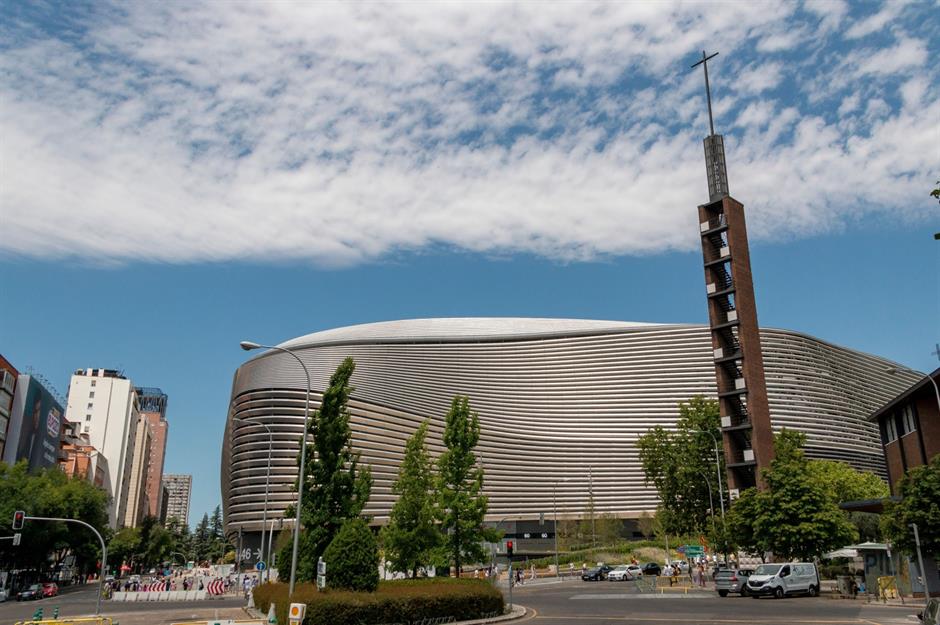
Along with an avant-garde façade, the upgraded venue now features a retractable roof and leisure amenities like a luxury hotel and shopping mall. The club hopes to transform the stadium into a tourist attraction, drawing in more than just football fans. In fact, it was confirmed in January that the stadium will host the Miami Dolphins American football team during the NFL’s international series in 2025.
For most of the renovation period, Real Madrid continued to play at Santiago Bernabeu, with one break from March 2020 to September 2021.
=7. Tottenham Hotspur Stadium, UK: $1.9 billion (£1.5bn)
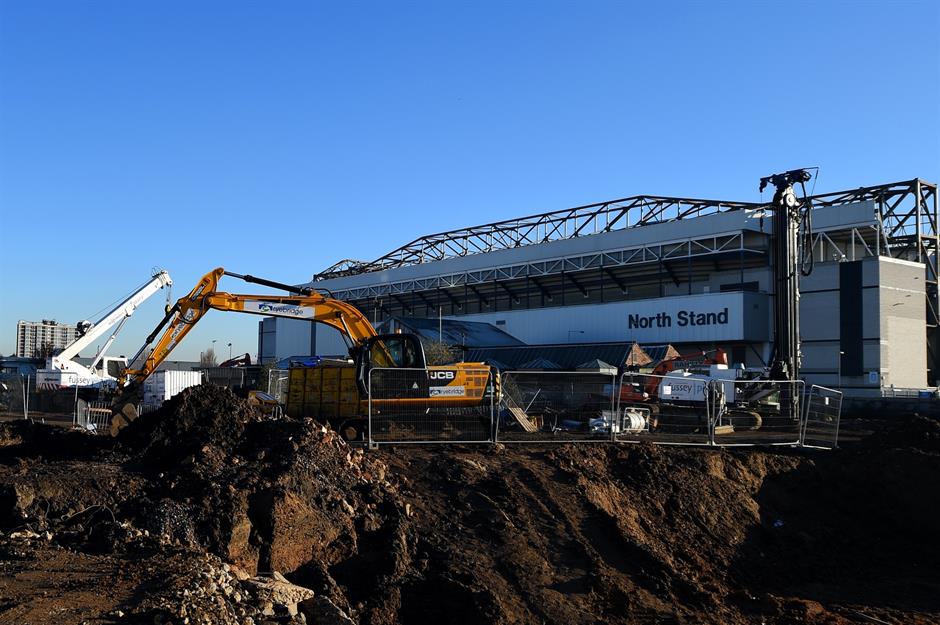
It cost roughly the same amount to build a new stadium for the Premier League’s Tottenham Hotspur, who moved into the replacement for White Hart Lane in 2019 at a cost of £1.2 billion. That's £1.5 billion ($1.9bn) today.
While construction only took three years, with the team playing two seasons at Wembley Stadium in the interim, the idea of a new facility dated back at least two decades. Various options for Tottenham’s new home even included taking over the Olympic Stadium in London’s nearby Stratford neighbourhood – a move that would have saved hundreds of millions in construction costs but which sparked instant backlash.
The club secured planning permission for a new facility adjacent to the existing White Hart Lane in September 2011, and the privately-funded project began construction in 2015.
=7. Tottenham Hotspur Stadium, UK: $1.9 billion (£1.5bn)
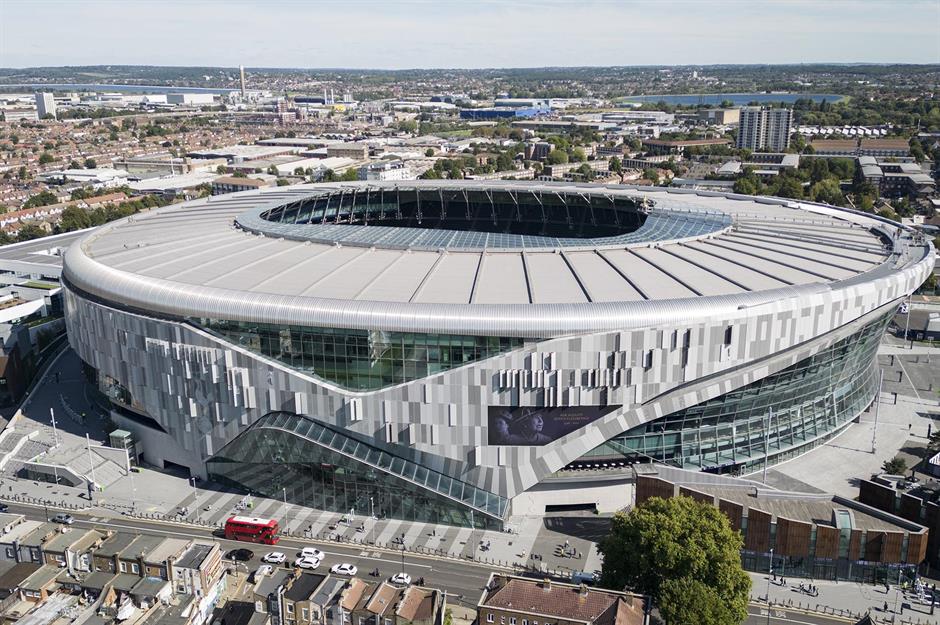
The club’s wishlist included flashy new amenities to transform the football grounds into a world-class entertainment venue and “maximise revenue at all times”, according to Forbes. There’s a microbrewery and heated seats, and it’s the first purpose-built NFL stadium outside of the US to feature an artificial turf hidden below the pitch. It hosts at least two NFL games a season in London.
Beyond sports, its 62,850-seat configuration for concerts makes it the largest club stadium in London, bringing in big names in music and entertainment. For example, Beyoncé will perform six shows there this summer as part of her upcoming tour.
6. Intuit Dome, USA: $2 billion (£1.5bn)
Los Angeles is home to two NBA teams: the Los Angeles Lakers and the LA Clippers. Neither team originated in the city, but eventually both found their way there through a series of sales that moved them to California. The Clippers struggled for many years, even being described as “perpetually lousy” before billionaire and former Microsoft CEO Steve Ballmer took ownership in 2014 – a watershed moment that marked a new era of success for the team.
As you might imagine, there’s a heady rivalry between the two, especially considering that up until last summer, the two sides shared Crypto.com Arena (formerly known as the Staples Center).
6. Intuit Dome, USA: $2 billion (£1.5bn)
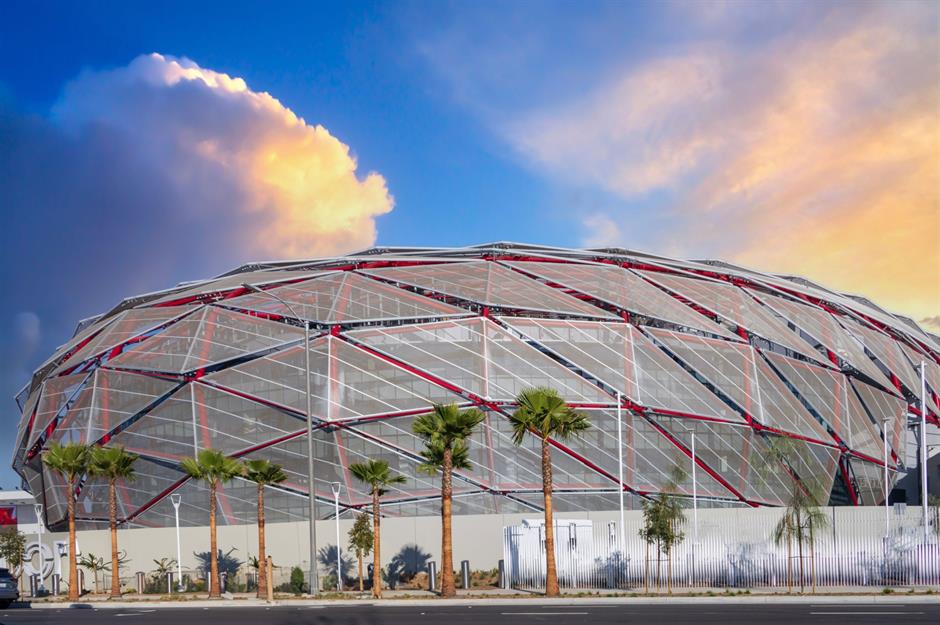
With Ballmer’s backing, the Clippers set out to build their own stadium in Inglewood, with costs estimated at $1.2 billion (£930m) when construction started in September 2021. With post-COVID inflation, that figure grew to at least $2 billion (£1.5bn), making the 18,000-seat Intuit Dome one of the most expensive stadiums in the world – though it's also one of the smallest on this list.
Said to have spared no expense, the high-tech arena offers facial recognition software for ticketing, a massive 'halo' scoreboard that encircles the top of the stadium and luxury suites. It also boasts some sustainability credentials thanks to solar panels and heat pumps.
5. Mercedes-Benz Stadium, USA: $2.1 billion (£1.6bn)
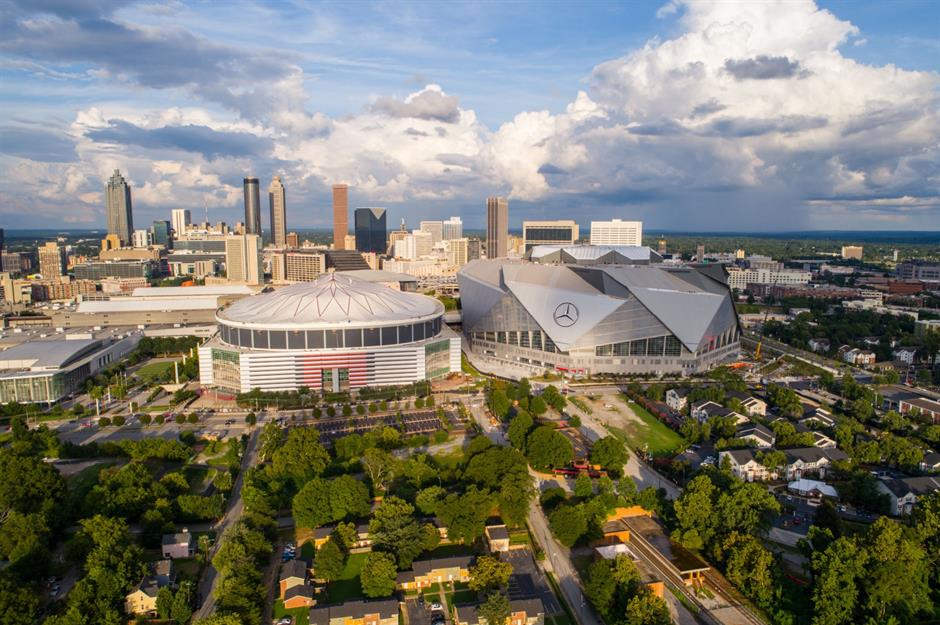
When the Georgia Dome opened in 1992, it was the largest covered stadium in the world. For 25 years, it was the home of the NFL’s Atlanta Falcons, Georgia State University’s American football team and the annual Peach Bowl tournament, among many other events. However, it no longer met the requirements for hosting the Super Bowl.
In an effort to build an upgraded facility for the Falcons, having secured around $200 million (£155m) of public funds to aid the project, construction started in 2014 for the 72,000-seat Mercedes-Benz Stadium. It opened in 2017 at a cost of $1.6 billion, or $2.1 billion (£1.6bn) in 2025 money.
The picture shows the Georgia Dome (left) before its demolition, and the new Mercedes-Benz Stadium (right).
5. Mercedes-Benz Stadium, USA: $2.1 billion (£1.6bn)
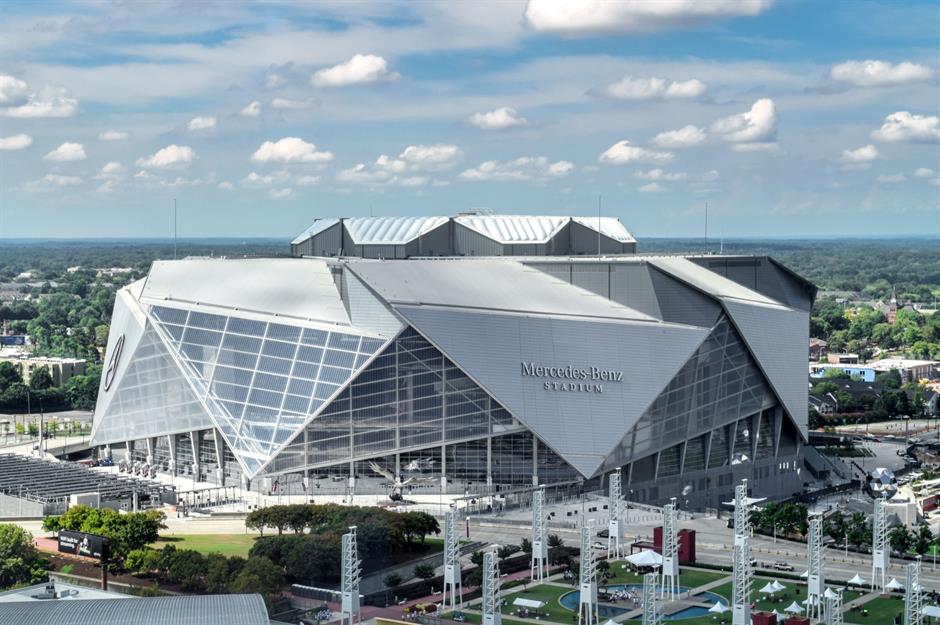
The new facility isn’t without controversy. The surrounding neighbourhood has long struggled with economic insecurity, and plans for the new venue raised concerns about gentrification as investors bought up adjacent land. Residents also sued the team in 2017 over $26 million (£20m) in unpaid property taxes, which the state supreme court later ruled against.
Like all the recently built stadiums on this list, the Mercedes-Benz Stadium is capable of hosting a vast range of sporting events, concerts and more. It boasts sustainability credentials and high-tech features, such as facial recognition for ticketless entry and checkout-free food and drink sales.
=3. Allegiant Stadium, USA: $2.3 billion (£1.8bn)
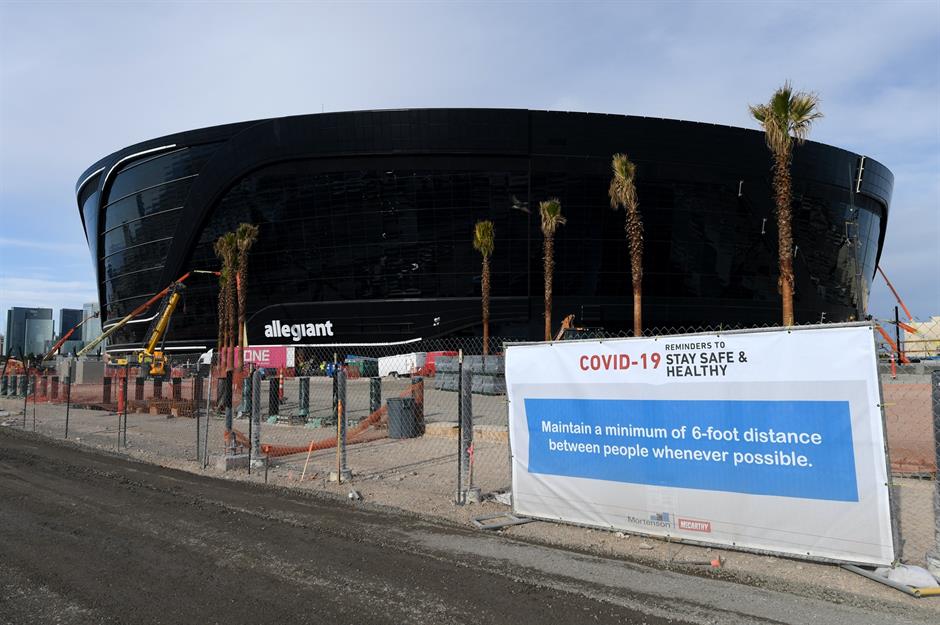
Finding a new home is an old habit for the NFL’s Las Vegas Raiders. Previously known as the Oakland Raiders, the team moved to Los Angeles in the 1980s, and then back to Oakland in 1995, before heading east to Las Vegas in 2019.
The move also upgraded the club’s home turf from a shared facility with the Oakland Athletics Major League Baseball team to a purpose-built stadium, paid for with $750 million (£580m) in public subsidies. The project was completed on time and on budget at $1.9 billion when it opened in 2020. That's $2.3 billion (£1.8bn) in today's money.
=3. Allegiant Stadium, USA: $2.3 billion (£1.8bn)
Featuring a specially designed glass roof for sun protection, entertainment lounges, a nightclub and massive doors that open on to the famous Las Vegas strip, the stadium has been designed to provide day-long entertainment for fans. Purpose-built for the team, the black façade with silver lighting is distinctively on brand for the Raiders.
With a retractable grass playing field, the 65,000-seat facility can be expanded to accommodate 7,000 people outside of gameday, completely adaptable for concerts and other off-season entertainment. In fact, Allegiant Stadium generated more than $70 million (£54m) from events unrelated to Raiders games in 2023, more than any other NFL stadium.
=3. MetLife Stadium, USA: $2.3 billion (£1.8bn)
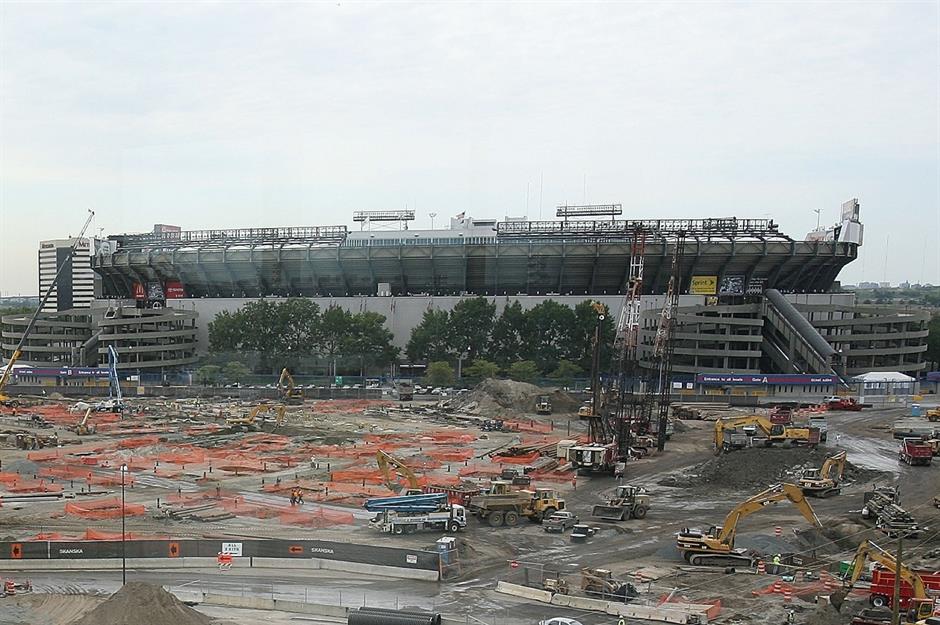
Located in East Rutherford, New Jersey, MetLife Stadium is home to two different New York NFL teams: the Jets and the Giants. The rivals have long shared a venue, and in 2010 they even split the $1.6 billion construction costs ($2.3bn/£1.8bn today) to replace Giants Stadium.
Purpose-built for sharing, the stadium has 10,000 club seats and 200 luxury suites and has been designed with coloured illumination and video screening to provide a distinctive setting for each team.
=3. MetLife Stadium, USA: $2.3 billion (£1.8bn)
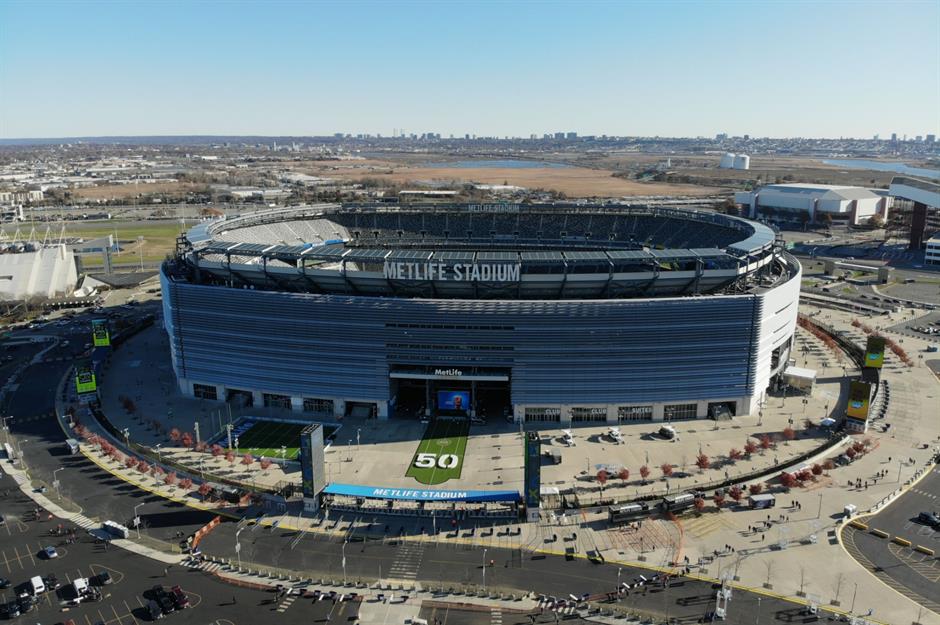
Just 5 miles (8km) from New York City, the 82,500-seat stadium has hosted many of the world’s top sporting events over the last 15 years. It’s also a popular stop on concert tours, with many of the biggest musicians often performing multiple shows.
Major renovations this year will increase the size of the playing field by removing 2,000 seats, enabling the stadium to host games for the 2026 FIFA World Cup, including the final. The works are estimated to cost $14 million (£11m).
2. Yankee Stadium, USA: $3.4 billion (£2.6bn)
On the other side of the Hudson River you'll find Yankee Stadium, which opened in 2009 at a cost of more than $2.3 billion, or $3.4 billion (£2.6bn) today. It replaced the previous stadium (pictured upper left) that dated back to 1923 and is currently home to Major League Baseball’s New York Yankees.
Around $1.2 billion (£920m) of the 47,400-seat stadium's total cost came from public funds, according to the New York Times. Initially expected to cost $1.3 billion (£1bn) in 2006, the project was already 30% over budget within two years. The city, which had already provided $942 million (£728m) in bonds to cover the costs, sold another $350 million (£270m) worth of tax-free municipal bonds to bolster its funds.
2. Yankee Stadium, USA: $3.4 billion (£2.6bn)
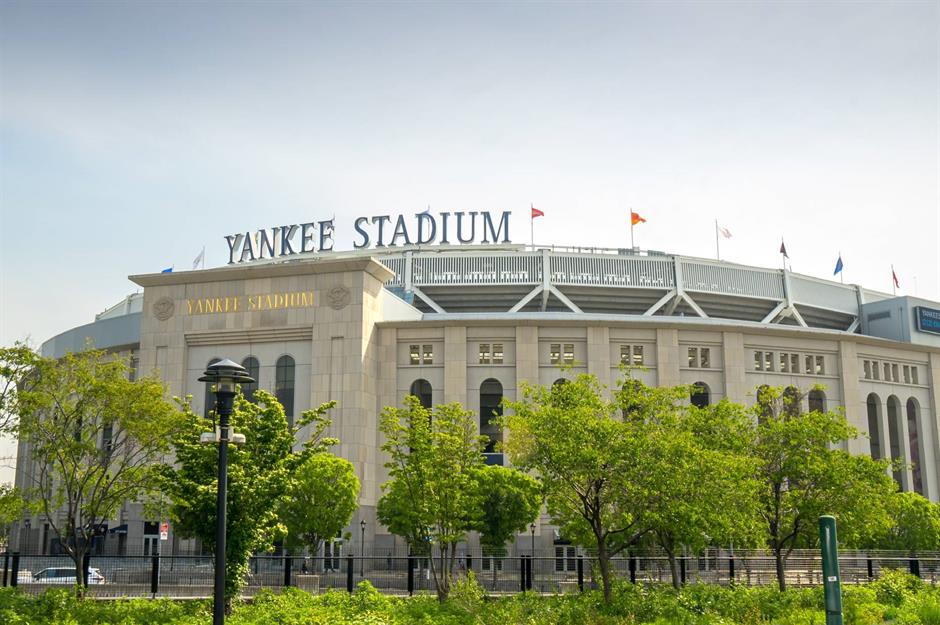
The only baseball stadium to make the list, the second most expensive stadium ever built is largely used as a ballpark. MLB teams typically play 162 games per season, half at home, and more if they make the playoffs.
Though it's hosted several Major League Soccer matches, along with occasional collegiate sports, it’s not a venue positioned to attract mega-entertainment events. A sports stadium through and through, it offers tours and is home to the New York Yankees Museum.
1. SoFi Stadium, USA: $6.8 billion (£5.3bn)
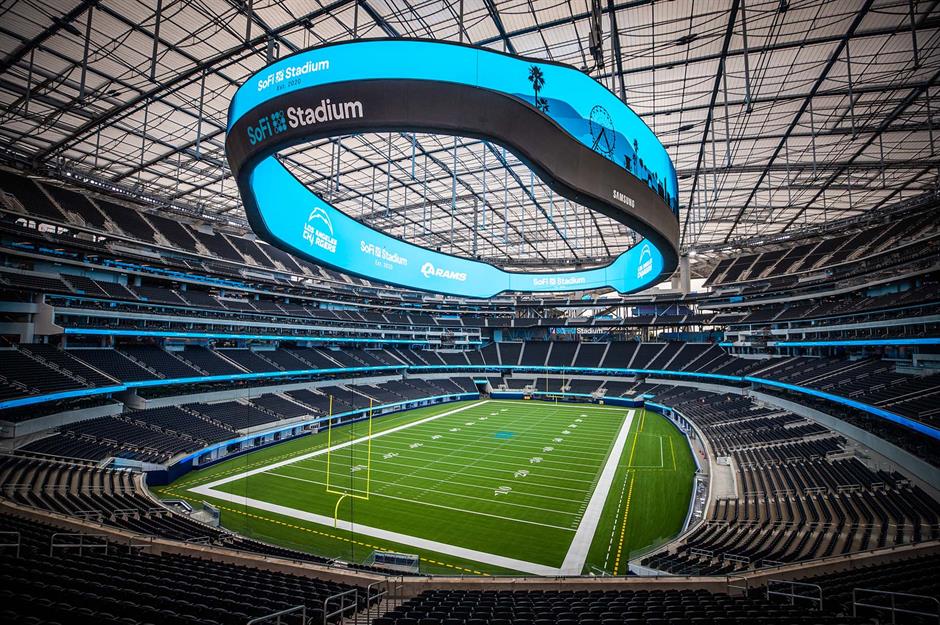
The most expensive stadium ever built is SoFi Stadium, another shared NFL facility located in Los Angeles.
It was initially meant to be used solely by the LA Rams, but brought the Los Angeles Chargers on board during the planning process for the privately funded, $5.5 billion project (almost twice the original estimate). Adjusted for inflation, that price tag climbs to an astronomical $6.8 billion (£5.3bn).
The project broke ground in 2016, and construction was expected to last just three years. However, it was delayed due to extreme rainfall and finally opened in 2020.
1. SoFi Stadium, USA: $6.8 billion (£5.3bn)
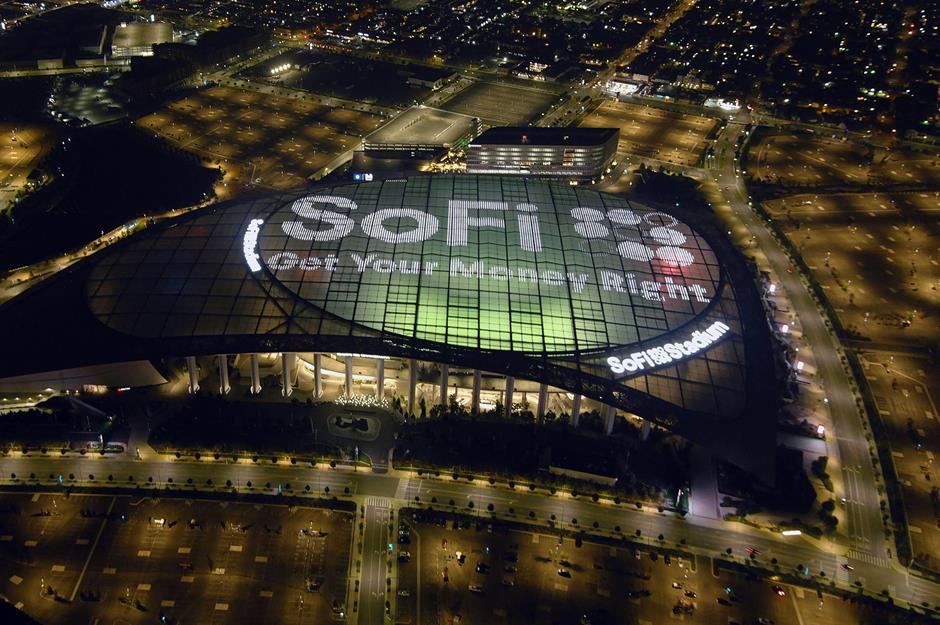
It’s the largest facility in the NFL and is designed to be a destination for major sporting events like the Super Bowl, as well as concerts and other entertainment. The 70,200-seat stadium expands to a capacity of more than 100,000 and offers 260 executive suites among other luxury amenities.
Part of the stadium’s steep cost is due to its ambitious engineering. The field is sunk into the ground as a protective measure for any seismic activity, and for similar reasons, the free-standing roof doesn’t connect to any of the facility’s walls – there are 37 massive, earthquake-resistant columns holding it up. The roof is also anchored by a colossal double-sided video screen centred over the field. This also provides a rooftop screen so passengers going to and from nearby LAX airport can catch a glimpse of the game during takeoff and landing.
Now discover 19 astonishing megaprojects that never happened
Comments
Be the first to comment
Do you want to comment on this article? You need to be signed in for this feature